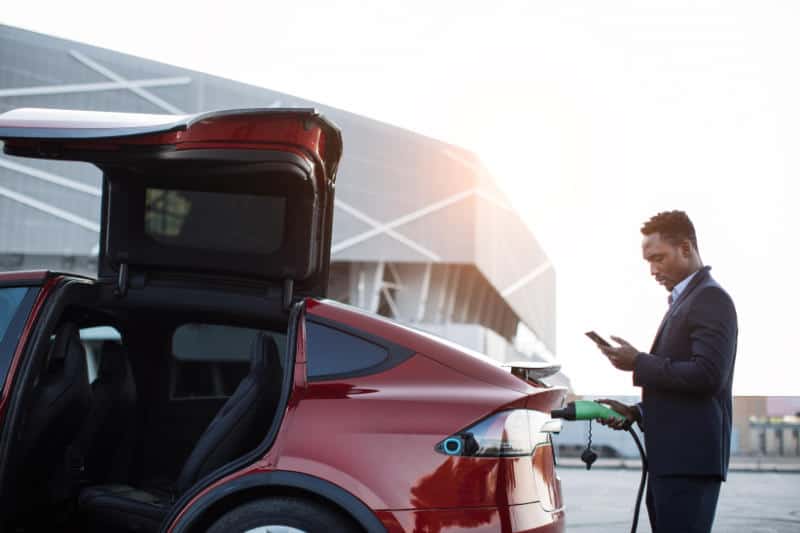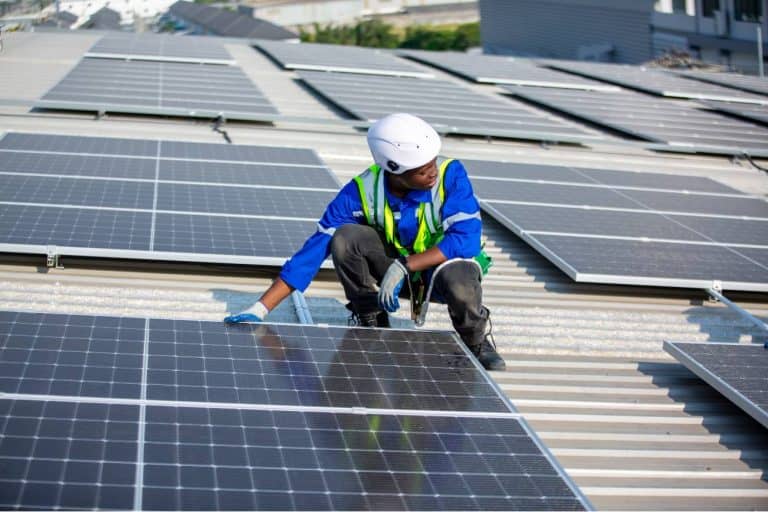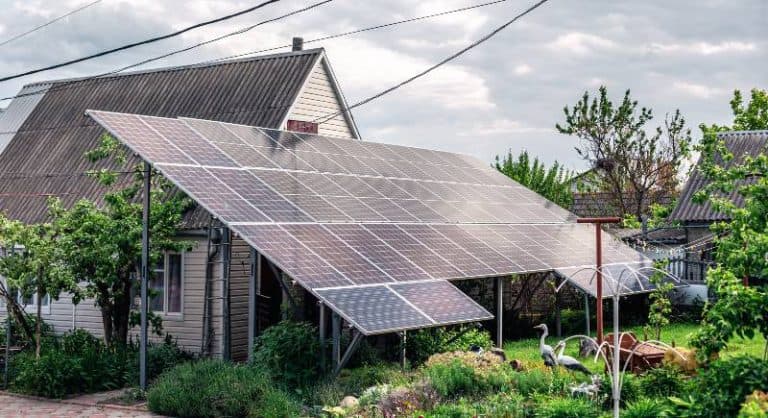Can You Use Portable Solar Panels to Charge a Tesla?
Have you ever wondered if you could use portable solar panels to charge your Tesla? Many people are interested in sustainable living and powering their homes with renewable energy, but may not know how feasible it is to use solar power to charge an electric car. In this blog post, we’ll explore the possibility of using portable solar panels to charge a Tesla, and answer some common questions about them. Let’s get started!
It is just not possible to charge a Tesla with portable solar panels using the technology that is now available. The portable solar panels available today are not powerful enough to provide an adequate charge for an electric vehicle.
Key Takeaways
- With solar panels needed, it would take roughly 10 days to charge a Tesla Model S.
- You could anticipate producing about 20 watt-hours per square foot if the weather was ideal and the solar panel was positioned perfectly.
- Solar panels are a great idea, but you should be aware that it will take a lot of time and money to create enough energy to drive an electric car.

Getting to know your portable solar panel
Portable solar panels are an excellent way to power your devices while you’re on the go. They can be used for camping, hiking, other outdoor activities, or even for emergency preparedness. They are especially useful for charging your phone in areas where there is no power outlet available. Smaller portable solar panels can even be used at home to charge small electronic devices such as a laptop or computers.
Portable solar panels are great for camping, gadgets, hiking, and other outdoor activities. The device converts sunlight into electrical energy through photovoltaic (PV) cells which make up part of their efficiency in terms of converting light to power – this depends on many factors including how big each panel is as well as what kind there happens to absorb more than others.
Technically, it is possible to charge an electric car like a Tesla with a solar panel of any size. But it is not a good idea to do this with portable solar panels. Electric cars need a lot of power, much more than a single portable solar panel can make in more than 100 days of bright sunshine. To get your car moving again, you would need a lot of solar panels and a lot of sunlight.
Three main things will affect how much energy your portable panel makes: the size of the panel, the material it is made of, and how much sun it gets. Most portable solar panels on the market today can produce up to 150–200 watts of power at most.
Kilowatt-hours are the most common way to measure electrical energy. A kilowatt-hour is the amount of power used by a thousand watts for 60 minutes.
Kilowatt-Hour (kWh) = Watts x Time (Hours) / 1000
So, if you have a 200W panel and it gets 7 hours of sunlight, it will produce 1.4 kWh. Bear in mind that it is the best output during direct midday sunlight. Most panels have an efficiency rating of 20%, which makes the output much less.
What does this maths mean in reality?
This means that if you have a modern Tesla with batteries that can hold 100 kWh, one day of power from one panel will only give you enough power to drive 0.28 miles. In reality, it would be a lot less than this, because it is impossible to guarantee perfect conditions (like direct midday sunlight) for the whole day. With a bit more math, you can figure out that a week of constant charging will only give you two miles.
As you can see, portable solar panels cannot be used to charge a Tesla. We just don’t have the right technology yet. But this doesn’t mean that using solar power to power your home or business isn’t a good idea.
How long would it take to charge a Tesla with solar panels?
It would take approximately ten days to charge a Tesla Model S with solar panels required. If you had perfect weather conditions and the solar panel was placed in an optimal position, you could expect to generate around 20 watt-hours per square foot.
To give you some perspective, the average home uses about 900 kWh of electricity per month. This means that you would need 45,000 square feet of solar panels to completely offset your home’s electricity usage. And that’s not including the cost of batteries to store the extra battery power for nighttime use.
So, while solar panels are an excellent idea, keep in mind that it will take a significant amount of time and money to generate enough power to run an electric car. For now, it’s best to stick to charging your Tesla at a traditional power outlet.
How many portable solar panels do a Tesla need to be charged?
We’ll use the portable solar panel as an example. It can make about 1 kWh of AC electricity per day. If you use this to charge the batteries of a Tesla car, you would need an impressive 75 portable solar panels kept in the bright sun to generate electricity for the Tesla Model S at its full capacity.
Can you use multiple portable panels?
Yes, you can use multiple portable solar panels to charge a Tesla. You would need around seven to ten hours of sunlight to charge the car from 0% to 100%. However, this is an impractical way to charge a Tesla.
A better option would be to use a home solar panel system or a public charging station. Solar panels are becoming more popular as technology improves and the cost of installation decreases.
Additionally, public charging stations are becoming more common as the electric car market grows. You can find them at some parking garages, shopping centers, and workplaces.
Portable solar panels are a great way to generate renewable energy, but they’re not practical for charging a Tesla. If you have an electric car, consider using a home solar panel system or public charging station.
The practicalities of charging a Tesla with portable solar panels
As we said at the start of this article, you can use portable solar panels to charge your Tesla. But there are a lot of reasons why it’s not a good choice (yet). Here are some of the main reasons why:
Solar panels just don’t generate enough power.
Even if you had perfect conditions (like direct midday sunlight), it would take a lot of panels to generate enough power consumption to charge Tesla batteries.
Portable solar panels are not very efficient
Most panels have an efficiency rating of 20%, which means that they only convert 20% of the sunlight that hits them into electricity.
Portable solar panels are also very expensive
A single panel can cost anywhere from $200 to $1000. When you factor in the cost of batteries, installation, and maintenance, the price skyrockets.
What does Tesla say?
In 2017, Elon Musk, the CEO of Tesla, said that the Model might have a solar panel built into the roof of the car. He later took back what he had said, saying that it wouldn’t be that helpful because the car’s surface isn’t that big and most cars are inside. Additionally, he said that cars are the worst place to put solar panels.
So, there you have it. While you can technically use portable solar panels to charge a Tesla, it’s not a practical solution. If you have an electric car, your best bet is to use a home solar panel system or public charging station.

How to set up portable solar panels for Tesla: Step-by-step Guide
If you’re looking to go off the grid and charge your Tesla, portable solar power is one of the best viable options. With a portable solar panel system, you can harness the sun’s energy wherever it’s located and use it to charge your car.
There are a few things to keep in mind when using a portable solar panel system with your Tesla. Here’s what you need to know:
Set up the portable solar panel near the Tesla
The goal is to place the solar panel in a location that will maximize sunlight exposure and minimize shade from trees, buildings, and other objects.
Use a power converter
The power converter will convert the DC from the solar panel into AC, which is required by electric vehicles. Some power converters are designed for specific models of cars, but there are also universal converters that can be used with many different cars. If you do not know which one to buy, you can contact your nearest electrician or search online for more information.
Now, you are good to go! Start charging your Tesla with portable solar panels.
What is the alternative option to charge a Tesla?
The home charging station is the most common way for people to charge their Tesla cars. This is because you can use electricity as much as you want, and you can charge your car any time of the day or night. The other alternative is to use public charging stations in places where there are a lot of people, like shopping malls. But this may not be as convenient as being able to charge your car at home without worrying about who else needs to use the charger at the same time.
What Can We Expect In The Future
As technology advances, solar panels will likely become more efficient and less expensive. This means that they could eventually become a practical option for charging a Tesla. Until then, home solar panel systems and public charging stations are the best way to charge an electric car.
Can a Single Solar Panel Charge a Tesla?
No, a single solar panel cannot charge a Tesla. Solar panels are not very efficient at converting sunlight into electricity, and they’re also quite expensive. If you have an electric car, your best bet is to use a home solar panel system or public charging station.
How Much Power Does the Sun Produce on Earth?
On a sunny day, the sun gives off 1,000 watts per square meter of energy on the surface of the earth. If you can somehow make an excellent solar collector that could take in and use all of the sun’s energy, you could get 1,000 watts out of one square meter in ideal conditions. That is based on the idea that the sun is directly above us, which, of course, rarely ever happens.
Conclusion
Tesla has made great strides in the area of renewable energy, and it’s clear that they are committed to becoming a leader in this space. Portable solar panels offer a convenient way for people to reduce their reliance on fossil fuels, and we hope that Tesla continues to develop products that make it easier for people to use renewable energy.
In the future, solar panels may become a practical option for charging a Tesla. Until then, home solar panel systems and public charging stations are the best way to charge an electric car.






